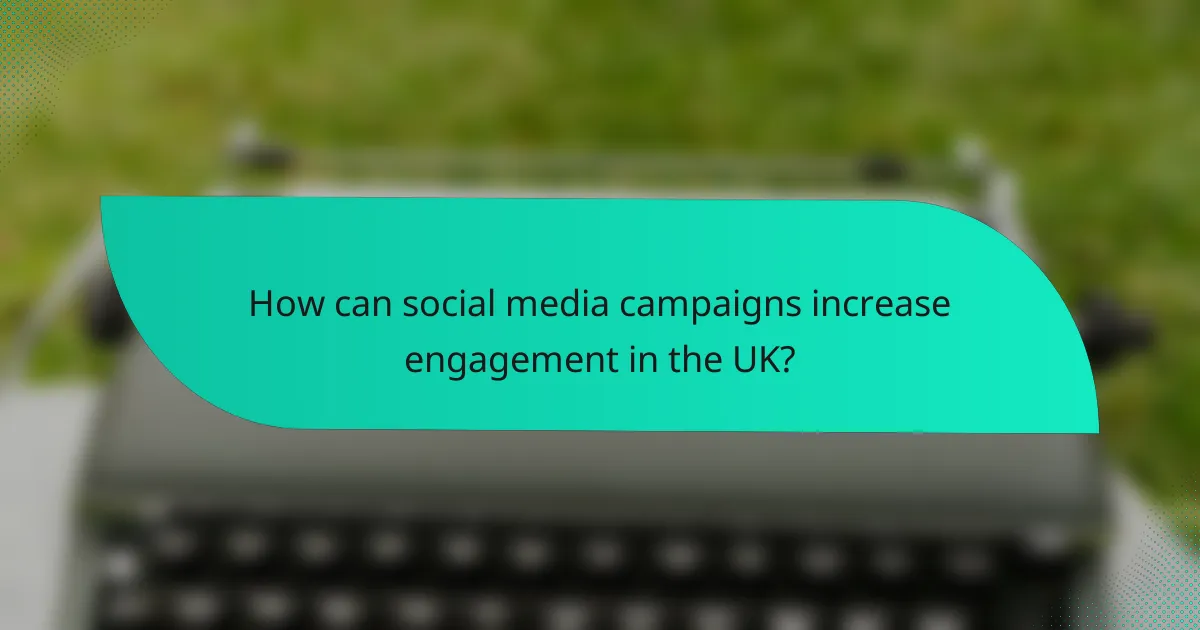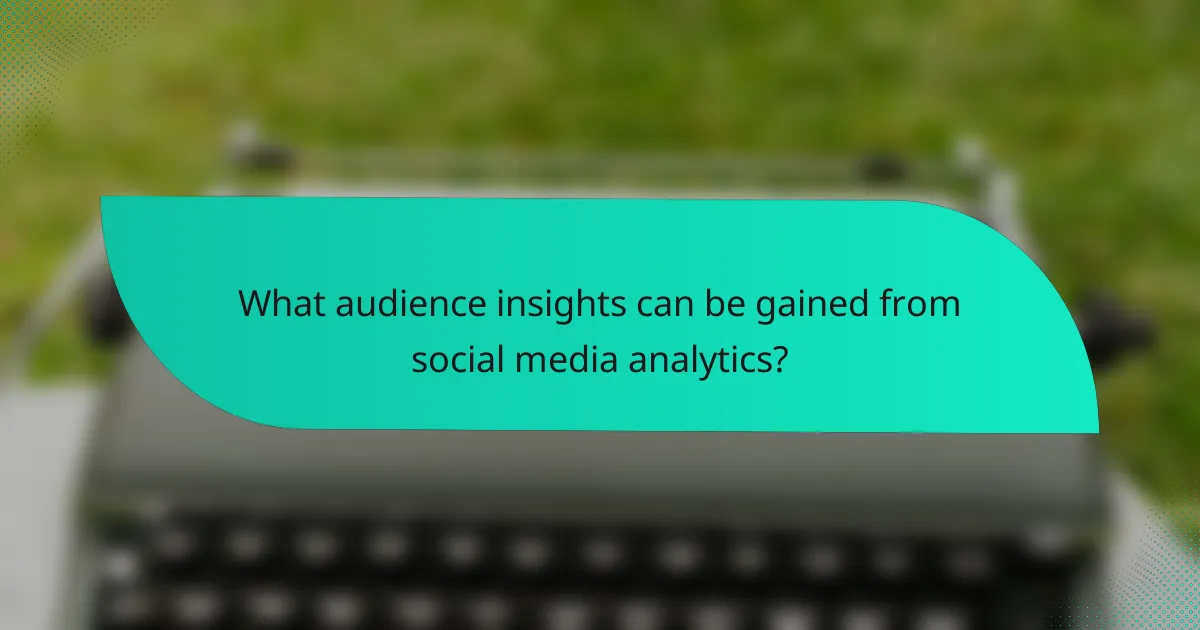Social media campaigns play a crucial role in enhancing engagement by enabling direct interactions between brands and their audiences. By leveraging targeted strategies, businesses can foster a participatory environment that not only boosts engagement but also cultivates brand loyalty through consistent messaging and community building. Additionally, utilizing social media analytics offers valuable insights into audience demographics and preferences, allowing brands to tailor their campaigns for maximum impact.

How can social media campaigns increase engagement in the UK?
Social media campaigns can significantly boost engagement in the UK by fostering direct interaction between brands and their audiences. By employing various strategies, brands can create a more dynamic and participatory experience that encourages users to connect and respond.
Utilizing interactive content
Interactive content, such as polls, quizzes, and surveys, invites users to engage actively rather than passively consuming information. This type of content can increase user participation and enhance the overall experience, leading to higher engagement rates. For example, a fashion brand might create a quiz to help users find their perfect outfit, encouraging shares and comments.
Leveraging user-generated content
User-generated content (UGC) involves sharing content created by customers, which can enhance authenticity and trust. Brands can encourage UGC by hosting contests or challenges that prompt users to share their experiences. For instance, a travel company could ask customers to post photos from their trips using a specific hashtag, creating a community feel and increasing engagement.
Implementing targeted ads
Targeted ads allow brands to reach specific demographics based on user interests and behaviors, making them more effective in driving engagement. In the UK, platforms like Facebook and Instagram offer advanced targeting options to ensure ads reach the right audience. Brands should regularly analyze ad performance to refine their targeting strategies and maximize engagement.
Hosting live events
Live events, such as Q&A sessions or product launches, create a sense of urgency and exclusivity, encouraging users to participate in real-time. These events can be streamed on platforms like Instagram Live or Facebook Live, allowing for immediate interaction through comments and questions. Promoting these events ahead of time can build anticipation and drive higher engagement during the broadcast.
Creating shareable visuals
Visual content, particularly images and videos, is more likely to be shared than text-based content. Brands should focus on creating high-quality, visually appealing graphics that resonate with their audience. Infographics, memes, and short videos can effectively convey messages and encourage users to share them, amplifying engagement across social media platforms.

What strategies build brand loyalty through social media?
Building brand loyalty through social media requires a combination of consistent messaging, active engagement, exclusive offers, and community building. These strategies help create a strong emotional connection with your audience, leading to increased loyalty and long-term relationships.
Consistent brand messaging
Consistent brand messaging ensures that your audience receives a unified message across all social media platforms. This includes using the same tone, visuals, and key messages that reflect your brand’s identity. For example, a brand that emphasizes sustainability should consistently highlight eco-friendly practices in all posts.
To maintain consistency, develop a style guide that outlines your brand’s voice, colors, and messaging themes. Regularly review your content to ensure it aligns with these guidelines, which can help reinforce brand recognition and trust.
Engaging with followers
Engaging with followers is crucial for building loyalty as it fosters a sense of connection and community. Respond to comments, answer questions, and acknowledge feedback to show that you value your audience’s input. This interaction can turn casual followers into loyal advocates.
Consider hosting live Q&A sessions or polls to encourage participation. These activities not only provide valuable insights into your audience’s preferences but also make followers feel heard and appreciated.
Offering exclusive promotions
Exclusive promotions can incentivize followers to remain loyal to your brand. Offering discounts, early access to new products, or special giveaways can create a sense of belonging and appreciation among your audience. For instance, a clothing brand might provide a 20% discount to followers on their birthday.
Make sure to promote these exclusive offers through your social media channels to maximize visibility. Highlight the limited-time nature of these promotions to encourage immediate action and reinforce the value of being part of your brand’s community.
Building community through groups
Creating groups on platforms like Facebook or LinkedIn can help cultivate a loyal community around your brand. These groups provide a space for followers to connect, share experiences, and discuss topics related to your brand. This sense of community can significantly enhance brand loyalty.
To effectively build a community, actively participate in discussions, share valuable content, and encourage members to engage with one another. Regularly hosting events or discussions within the group can further strengthen relationships and keep members invested in your brand.

What audience insights can be gained from social media analytics?
Social media analytics provide valuable audience insights that help brands understand their followers’ demographics, behaviors, and preferences. By analyzing this data, businesses can tailor their campaigns to increase engagement and foster brand loyalty.
Demographic data analysis
Demographic data analysis involves examining the age, gender, location, and interests of your audience. This information helps brands identify their target market and tailor content to resonate with specific groups. For instance, a brand targeting millennials may focus on platforms like Instagram and TikTok, while a company aiming at older demographics might prioritize Facebook.
Utilizing tools like Facebook Insights or Twitter Analytics can provide a clear picture of who your audience is. Regularly reviewing this data ensures your marketing strategies align with the evolving preferences of your audience.
Engagement rate tracking
Engagement rate tracking measures how actively your audience interacts with your content, including likes, shares, comments, and clicks. A higher engagement rate indicates that your content resonates well with your audience, while low rates may suggest a need for content adjustment. Aim for engagement rates between 1% to 5% depending on the platform.
To improve engagement, consider experimenting with different content types, such as videos, polls, or user-generated content. Regularly monitor engagement metrics to identify trends and adjust your strategy accordingly.
Content performance metrics
Content performance metrics assess how well your posts are performing in terms of reach, impressions, and conversions. Understanding which types of content drive the most traffic can help you refine your strategy. For example, if video content consistently outperforms static images, prioritize video production in your campaigns.
Utilize A/B testing to compare different content formats and identify what works best for your audience. This approach allows for data-driven decisions that can enhance overall campaign effectiveness.
Sentiment analysis
Sentiment analysis evaluates the emotional tone of audience interactions with your brand on social media. By analyzing comments, reviews, and mentions, brands can gauge public perception and identify potential issues. Tools like Brandwatch or Hootsuite can help automate this process.
Understanding sentiment can guide your communication strategy. If sentiment is predominantly negative, it may be necessary to address concerns directly or adjust your messaging. Regular sentiment checks can help maintain a positive brand image and foster loyalty among your audience.

What are the prerequisites for a successful social media campaign?
Successful social media campaigns require a clear understanding of objectives, a well-defined target audience, and the selection of appropriate platforms. These elements are essential for maximizing engagement, building brand loyalty, and gaining valuable audience insights.
Defining clear objectives
Establishing clear objectives is crucial for guiding your social media campaign. Objectives should be specific, measurable, achievable, relevant, and time-bound (SMART). For example, you might aim to increase engagement by 20% over three months or grow your follower base by 1,000 within a quarter.
Consider what you want to achieve: brand awareness, lead generation, or customer retention. Each goal will dictate different strategies and metrics for success. Regularly review and adjust your objectives based on performance data.
Identifying target audience
Understanding your target audience is key to tailoring your content and messaging effectively. Begin by analyzing demographics such as age, gender, location, and interests. Tools like social media analytics can provide insights into who engages with your brand.
Creating audience personas can help visualize your ideal customers. For instance, if your product appeals to young professionals in urban areas, your content should resonate with their lifestyle and preferences. Regularly update your audience profiles based on changing trends and behaviors.
Choosing the right platforms
Selecting the right social media platforms is essential for reaching your target audience effectively. Each platform has unique characteristics and user demographics. For example, Instagram is popular among younger users, while Facebook has a broader age range.
Evaluate where your audience spends their time and what type of content performs best on each platform. Consider using a mix of platforms to diversify your reach, but focus your efforts on those that align closely with your objectives and audience preferences. Regularly assess platform performance and adjust your strategy accordingly.

How do social media algorithms affect campaign success?
Social media algorithms play a crucial role in determining the visibility and reach of your campaigns. They prioritize content based on engagement, relevance, and user behavior, which directly influences how effectively your message resonates with your audience.
Prioritizing engagement metrics
Engagement metrics, such as likes, shares, and comments, are essential for assessing the success of your social media campaigns. Algorithms favor content that generates higher engagement, meaning that posts with more interactions are more likely to be shown to a broader audience.
To enhance engagement, focus on creating compelling content that encourages interaction. For example, ask questions, use polls, or share user-generated content to foster a sense of community. Regularly analyze which types of posts yield the highest engagement rates and adjust your strategy accordingly.
Understanding content visibility
Content visibility is influenced by how algorithms rank posts in users’ feeds. Factors like recency, relevance, and user preferences determine whether your content appears prominently or gets buried. Understanding these factors can help you optimize your posting schedule and content type.
To improve visibility, post during peak times when your audience is most active, and tailor your content to align with their interests. Experiment with different formats, such as videos or infographics, to see what resonates best. Keep an eye on algorithm changes and adapt your strategies to maintain high visibility in a competitive landscape.
